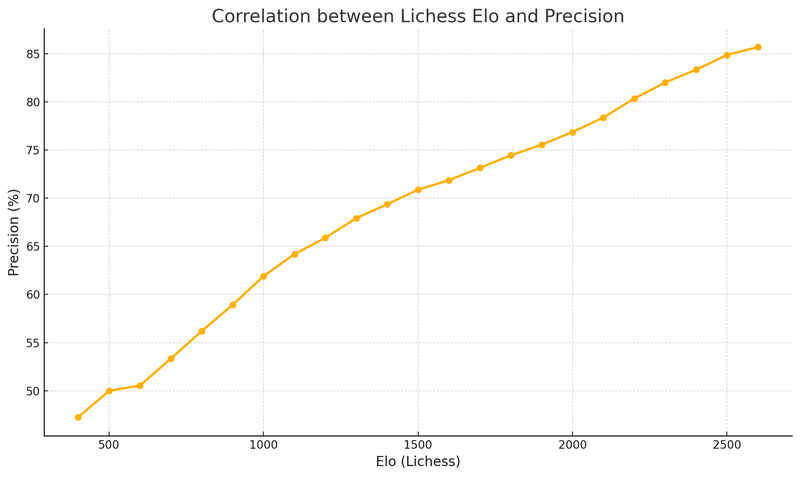
Do Stronger Players Play More Accurately? I Analyzed 35,000 Games to Find Out
As chess enthusiasts, we've all heard that higher-rated players make better moves. But how true is this? To explore this, I analyzed 35,000 games from Lichess to investigate the correlation between a player's rating and the precision of their play.Methodology
Here's how I conducted the study:
- Collected all Lichess games played in March 2025.
- Filtered for games with a 10-minute time control.
- Selected games where the rating difference between players was less than 50 Elo points.
- Randomly sampled 35,000 games, evenly distributed across average player ratings from 400 to 2600 Elo.
- Analyzed each game using Stockfish 17.1 at a depth of 13 to calculate the average precision of both players.
Understanding Precision
In this context, "precision" refers to how closely a player's moves align with the optimal moves suggested by Stockfish. For each move, Stockfish evaluates the position before and after the move, quantifying any loss in advantage. The precision score reflects the average of these evaluations throughout the game, providing a percentage that indicates the overall accuracy of play. A score of 100% would mean every move matched the engine's top choice.
Findings
The analysis revealed a clear trend: as player ratings increase, so does the average precision. Notably, there were no plateaus or declines at any rating level; the progression was consistently upward. This suggests that higher-rated players consistently make moves that align more closely with optimal engine recommendations.
The Significance of Equal Rating Matchups
A critical aspect of this study is the focus on games where both players have similar ratings (within a 50 Elo point difference). It's intuitive to expect that a higher-rated player would exhibit greater precision compared to a lower-rated opponent. However, this analysis reveals that even when players are evenly matched, those in higher Elo brackets consistently demonstrate greater precision.
This suggests that as players improve, they not only make more accurate moves but also maintain this accuracy against stronger opponents. The ability to sustain high precision in more challenging games underscores the depth of understanding and skill at higher levels.
Conclusion
The analysis confirms a strong correlation between player rating and move precision, even among evenly matched opponents. As players ascend the rating ladder, they not only face tougher competition but also enhance their ability to make precise moves consistently. This insight emphasizes the importance of accuracy and decision-making in the journey to higher levels of chess mastery.
*Data sourced from the Lichess database: https://database.lichess.org/*
*Note: For clarity I’ve used the term “Elo” throughout this document, but strictly speaking I should have referred to “Glicko‐2,” since that is the system Lichess actually uses.
